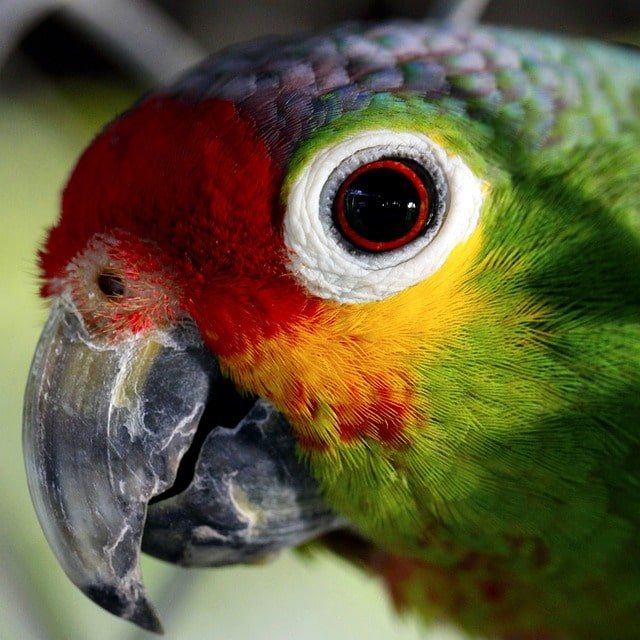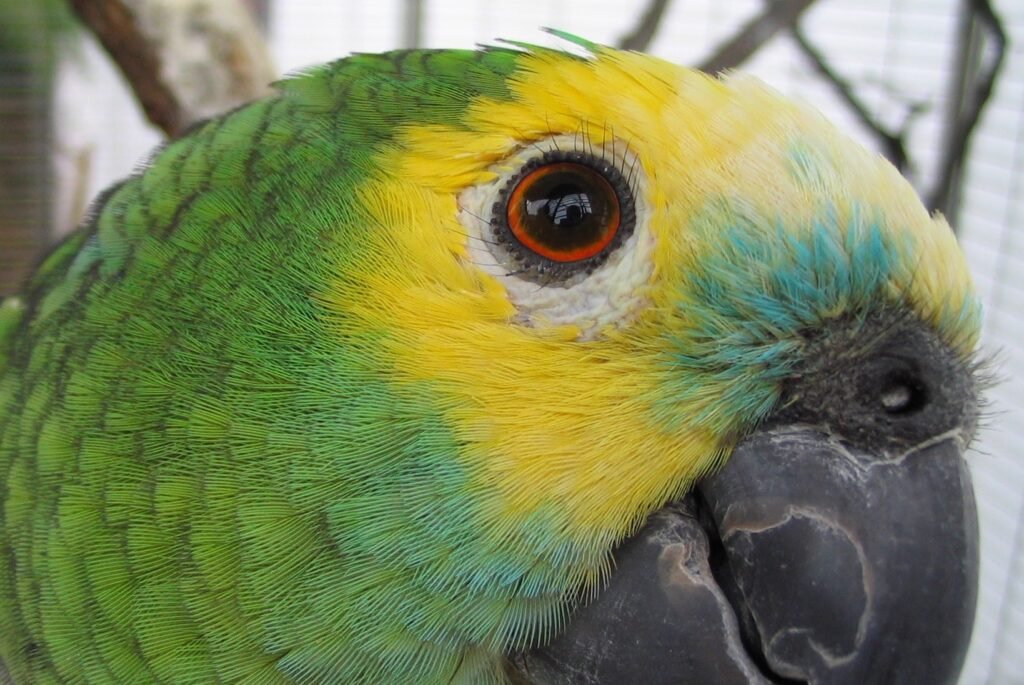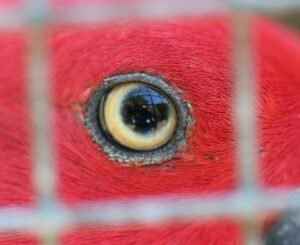Vision is one of the most important sensory tools for parrots, both in the wild and in captivity. It is how they stay aware of their surroundings and spot threats.
This means they cannot afford to lose sight of their enemies even for a second. So nature has afforded them an evolutionary advantage accordingly.
Parrots are one of the few species of birds that blink their eyes. They have upper and lower eyelids that open and close just like ours. But in addition to that parrots also have a third eyelid – the nictitating membrane which sweeps sideways across the surface of the eye.
However, parrots do not blink very often. The only time you may see their eyes closed is when they’re asleep.
Quick Navigation
Do Parrots Have Eyelids?
Parrots have three eyelids. They have conventional upper and lower eyelids that are controlled by the muscle around the eyes. Besides that, the parrot’s third eyelid, also called the nictitating membrane is a thin film and goes back and forth horizontally across the surface of the eye.

How Do Parrots Blink?
Parrots have outer eyelids that close vertically just like they do in humans. They are among the few species of birds that can do that. But they also have a third eyelid underneath the outer eyelids.
This third eyelid is known as the nictitating membrane. It works differently from the normal eyelids and slides horizontally across the parrot’s eyes. It protects the cornea without obstructing the parrot’s vision.
The nictitating membrane is a translucent film that enables parrots to see through even as they blink. It is a single film located in the inner corner of the eye from where it draws and retracts back in.
Why Do Parrots Have A Third Eyelid?
Besides blinking, the nictitating membrane serves a few important purposes for parrots. It is a specialized membrane that compliments the outer eyelids. Here
Protecting The Eye
Parrots have three eyelids to protect their eyes. The nictitating member is a thin covering located underneath the outer eyelids. It acts as a secondary protective layer for the cornea after the primary eyelids. It protects the eyes from foreign particles and also lubricates the eye.
Cleaning And Lubricating The Eye
Having a third eyelid is all the more important in the wild. Parrots possess an extra layer of defense with the third eyelid which helps prevent debris, dust, or any other foreign objects from directly coming into contact with the cornea. The nictitating membrane also aids in maintaining moisture on the eye’s surface, ensuring that it stays hydrated and well-lubricated.
Watching Out For The Predators
The blink of an eye is a matter of life and death in the wild. So when a parrot faces a threat, such as sudden movements or when it is flying through dense foliage, the nictitating membrane swiftly slides across the eye’s surface, helping the bird blink while maintaining virtually the same level of vision. It is a translucent film that does not completely block a parrot’s vision and helps avoid dangers.
During an encounter with a predator, parrots need to register visual information with their brain to plan their best move. This helps them maneuver deftly without losing eye contact with the predator.
Do Parrots Have Tear Ducts?
The nictitating membrane has a lubricating duct that acts as a source of moisture as well as a tear duct. However, parrots do not cry tears and the tear duct only serves as a lubricating channel for keeping the cornea moist and clean. It helps wipe off dirt and dust that gets in their eyes.
Do Parrots Have Eyelashes?
Parrots do have eyelashes although they may not be clearly visible from a distance. These are thin strands of hair growing on the upper part of the eyelid. These slightly resemble bristles. The size and length of the eyelashes can vary between species of parrots. However, they serve the same purpose as they do in humans – catching dust and protecting the eyeball from debris.

Do Parrots Close Their Eyes?
Parrots close their eyes when sleeping or when they’re roosting. Other times, they may not necessarily blink their eyes because that makes them more vulnerable to potential dangers in the environment.
You would be hard-pressed to see your parrot blink if you just waited for it. Parrots are hardwired to be vigilant creatures by years of adaptation to survive in the wild. Even in captivity, parrots remain vigilant, constantly looking for any signs of risk or changes.
Do Parrots Squint?
Parrots do not normally squint their eyes. If you notice your parrot closing one eye or squinting, it could be a sign of an eye problem.
Conjunctivitis and other types of eye infections can be some possible reasons why your parrot may squint.
Parrots sometimes partially close their eyes when they’re roosting which can look like they’re squinting. But if your parrot doesn’t appear to be napping, it should have its eyes wide open.
If a parrot has an eye infection, you would also notice other symptoms like swelling or redness around the eyes. The parrot may also seem lethargic.
Do Parrots Sleep With Their Eyes Open?
Parrots sleep with one or both eyes open commonly during the daytime. They do this as a way to keep a watchful eye so they can feel safe before going into REM sleep.
It is natural for parrots to feel vulnerable when their guard is down since in the wild they always have to be alert. Many parrots owners worry if it is normal behavior to keep the eyes open.
Parrots are able to do this because of their incredible ability to keep half of their brain awake while sleeping. This is known as Unihemispheric slow-wave sleep.
It is sometimes also referred to as peeking because the parrot intermittently takes short glances to stay alert to their surroundings. This behavior is deeply ingrained within them and serves as a to make them feel secure.
What Does It Mean When My Parrot Blinks At Me?
Parrots exhibit a number of body language signs to communicate their feelings. When a parrot blinks at you, it shows that it trusts you and is comfortable letting its guard down around you. Parrots hardly blink especially when they sense danger in their surroundings. As such, slow blinking is often associated with trust and affection, trust. It serves as a non-verbal communication method for them to convey their positive feelings toward someone.







